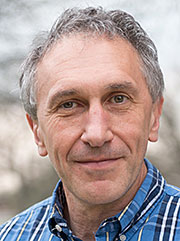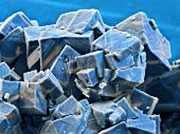-
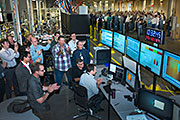 The brightest synchrotron light source in the world has delivered its first x-ray beams. The National Synchrotron Light Source II (NSLS-II) at Brookhaven Lab achieved "first light" on October 23, 2014, when operators opened the shutter to begin commissioning the first experimental station (called a beamline), allowing powerful x-rays to travel to a phosphor detector and capture the facility's first photons.
The brightest synchrotron light source in the world has delivered its first x-ray beams. The National Synchrotron Light Source II (NSLS-II) at Brookhaven Lab achieved "first light" on October 23, 2014, when operators opened the shutter to begin commissioning the first experimental station (called a beamline), allowing powerful x-rays to travel to a phosphor detector and capture the facility's first photons.
"This is a significant milestone for Brookhaven Lab, for the Department of Energy, and for the nation," said Harriet Kung, DOE Associate Director of Science for Basic Energy Sciences. "The National Synchrotron Light Source II will foster new discoveries and create breakthroughs in crucial areas of national need, including energy security and the environment. This new U.S. user facility will advance the Department's mission and play a leadership role in enabling and producing high-impact research for many years to come."
Full Story
-
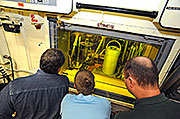 After years of waiting, a trans-Atlantic voyage and a cross-country trip, a cask containing four experimental irradiated pins of nuclear fuel arrived at DOE's Idaho National Laboratory in late July. The pins traveled from the Phénix fast reactor in France, where INL researchers had shipped them more than eight years ago. At the same time a parallel experiment was running here in the United States.
After years of waiting, a trans-Atlantic voyage and a cross-country trip, a cask containing four experimental irradiated pins of nuclear fuel arrived at DOE's Idaho National Laboratory in late July. The pins traveled from the Phénix fast reactor in France, where INL researchers had shipped them more than eight years ago. At the same time a parallel experiment was running here in the United States.
"These fuels are intended for use in a fast reactor, but we don't have a fast reactor available for testing in the U.S.," explained INL nuclear engineer Heather Chichester. "So we've been running experiments under modified conditions in ATR (INL's Advanced Test Reactor). We believe that the modifications we've made reproduce most of the important aspects of the environment inside a fast reactor, but we needed to confirm that."
Full Story
-
 A collaboration blending research in DOE's offices of High-Energy Physics with Basic Energy Sciences is yielding a one-of-a-kind X-ray detector. Results achieved with a powerful prototype detector featuring a 3-D imaging chip already have attracted attention from the scientific community.
A collaboration blending research in DOE's offices of High-Energy Physics with Basic Energy Sciences is yielding a one-of-a-kind X-ray detector. Results achieved with a powerful prototype detector featuring a 3-D imaging chip already have attracted attention from the scientific community.
The new type of detector boasts Brookhaven Lab sensors mounted on Fermilab integrated circuits linked to Argonne Lab data acquisition systems. It will be used at Brookhaven's National Synchrotron Light Source II and Argonne's Advanced Photon Source.
"This partnership between HEP and BES has been a fruitful collaboration, advancing detector technology for both fields," said Brookhaven's Peter Siddons.
Full Story
-
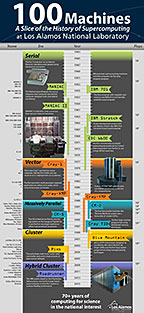 From the 1952 MANIAC to Bonanza deployed during November, DOE's Los Alamos National Laboratory has deployed 100 supercomputers in the last 60 years – a showcase of high-performance computing history.
From the 1952 MANIAC to Bonanza deployed during November, DOE's Los Alamos National Laboratory has deployed 100 supercomputers in the last 60 years – a showcase of high-performance computing history.
"The computing capability in our data centers in any given year dwarfs what was there 10 years before," said Randal Rheinheimer of the High Performance Computing division, "and Los Alamos has been on that curve for 60 years."
The Los Alamos computers deployed along the way include the MANIAC II, which started its nearly 20-year service life with over 5000 vacuum tubes, all of which were replaced over time with circuit boards. Any computing device today would have to be purpose-built to compute as slowly as the MANIAC computers. But compared to a room full of people with mechanical calculators, those early computing tools were significant advances, Rheinheimer notes. "It was the first and only triumph of serial over parallel computing."
Other deployed systems include Stretch, a technological stretch built in collaboration between Los Alamos and IBM, Serial Number 1 of the iconic Cray-1, and a Thinking Machines CM-5, with its lightning bolt footprint and fat-tree interconnect. "The fat-tree today seems an obvious topology, but we have detailed diagrams of it in our archive labeled 'Thinking Machines Proprietary'," says Rheinheimer.
Full Story
 The brightest synchrotron light source in the world has delivered its first x-ray beams. The National Synchrotron Light Source II (NSLS-II) at Brookhaven Lab achieved "first light" on October 23, 2014, when operators opened the shutter to begin commissioning the first experimental station (called a beamline), allowing powerful x-rays to travel to a phosphor detector and capture the facility's first photons.
The brightest synchrotron light source in the world has delivered its first x-ray beams. The National Synchrotron Light Source II (NSLS-II) at Brookhaven Lab achieved "first light" on October 23, 2014, when operators opened the shutter to begin commissioning the first experimental station (called a beamline), allowing powerful x-rays to travel to a phosphor detector and capture the facility's first photons. After years of waiting, a trans-Atlantic voyage and a cross-country trip, a cask containing four experimental irradiated pins of nuclear fuel arrived at DOE's Idaho National Laboratory in late July. The pins traveled from the Phénix fast reactor in France, where INL researchers had shipped them more than eight years ago. At the same time a parallel experiment was running here in the United States.
After years of waiting, a trans-Atlantic voyage and a cross-country trip, a cask containing four experimental irradiated pins of nuclear fuel arrived at DOE's Idaho National Laboratory in late July. The pins traveled from the Phénix fast reactor in France, where INL researchers had shipped them more than eight years ago. At the same time a parallel experiment was running here in the United States.  A collaboration blending research in DOE's offices of High-Energy Physics with Basic Energy Sciences is yielding a one-of-a-kind X-ray detector. Results achieved with a powerful prototype detector featuring a 3-D imaging chip already have attracted attention from the scientific community.
A collaboration blending research in DOE's offices of High-Energy Physics with Basic Energy Sciences is yielding a one-of-a-kind X-ray detector. Results achieved with a powerful prototype detector featuring a 3-D imaging chip already have attracted attention from the scientific community. From the 1952 MANIAC to Bonanza deployed during November, DOE's Los Alamos National Laboratory has deployed 100 supercomputers in the last 60 years – a showcase of high-performance computing history.
From the 1952 MANIAC to Bonanza deployed during November, DOE's Los Alamos National Laboratory has deployed 100 supercomputers in the last 60 years – a showcase of high-performance computing history. 